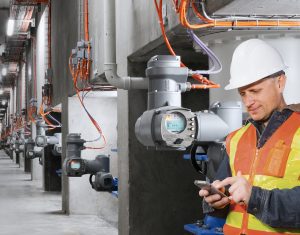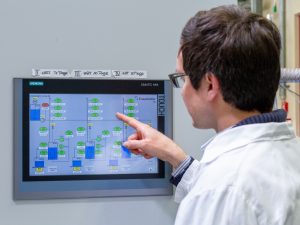The valve industry wins extensive orders for water and wastewater. For example, more than 400 AUMA actuators control wastewater treatment in the Jebel Ali sewage treatment plant serving the megacity of Dubai. Image courtesy of AUMA.
Digitalisation is one of today’s most important megatrends – including in water management. It offers opportunities for even more cost-effective, safer and cleaner processes.
Text and images by Messe Düsseldorf
In European countries, digitalisation enables increased efficiency and sustainability through the optimised evaluation of data collected by measuring systems on, for example, valves. In countries where water is scarce, it will, in theory, contribute to improved water supply. As a result, the worldwide demand for water and wastewater technology is enormous. Valves and actuators are an important component of Water Management 4.0. They must be smart, networkable and optimised; in other words, fit for the digital age.
In digital water management, the real and virtual worlds combine. Measuring devices, control systems and processes are networked. This integrated view of the system produces extensive amounts of data that can be transformed into information through appropriate analysis: decisions are being taken, implemented and monitored. A big step towards more effective water management.
Electric actuators from AUMA, for example, contribute to this. They “automatically collect and store process data such as valve position, ambient temperature and vibrations, as well as device data such as switching frequency, motor operation time and warning messages,” explains the company. It has developed a “digital ecosystem” that guides and supports the user throughout the lifecycle of the system. At the heart of this ecosystem is the AUMA Cloud. It interfaces with the software tools – the AUMA Assistant App and AUMA CDT.
It also gives users easy access to intelligent data analytics for their valves, access to complete equipment documentation and channels to contact AUMA service.
Virtual replication of system structure

In the AUMA Cloud, the system structure is represented virtually. Each actuator can be assigned to its associated valve, since the drive and the valve usually work as a single unit, and conclusions about the valve can also be inferred from the state of the actuator. “The analysis of key indicators enables plant operators to identify high loads or possible maintenance requirements at an early stage, and to start taking the appropriate measures,” explains AUMA. Premature wear can be minimised, and the service life of the actuators and valves can be significantly increased. The life cycle of the system is extended.
The management of a wastewater treatment plant requires continuous monitoring and data collection (SCADA), which oversees every step of the operation. According to Rotork, modern systems require real-time communication – right down to the factory level. “Plant managers are demanding more information faster than ever before. Process operators need comprehensive control options at any time of day or night. Maintenance managers need information so they can plan maintenance services economically,” explains Rotork.
To meet these requirements, the company’s designers build in field communication networks so that every part of the critical system can be monitored and controlled by computer. “These computers are responsible for management and maintenance tasks within their own network and exchange data about the devices and processes they control.” The Rotork Master Station can manage up to 240 actuators via three separate field networks, so that the appropriate type of network can be used in different areas of the plant. Rotork Intelligent Asset Management (iAM) is a cloud-based asset management system for intelligent actuators and flow control devices. Reports provided by iAM give predictive insights to increase plant availability.
Collection of unlimited amounts of data
Automation specialist Emerson also focuses on water management. The company has developed the Zedi SaaS SCADA platform. The flexibility of this cloud-based SCADA platform makes it possible to capture unlimited amounts of data from any digital monitoring hardware and quickly transfer it to the appropriate personnel who can access and analyse the data in real time to make faster and more informed decisions. The objective is to achieve significantly improved safety and monitoring. Emerson provides end users with a web interface and the ability to share data with third-party platforms, enabling remote control and optimisation through cloud-based data access. According to Emerson, digital transformation helps water management organisations optimise their operations, reduce costs and enhance safety, while also better protecting health and the environment.
Challenging demands in sewage treatment plants

Digitalisation can enable water management to take the next step forward. Of course, this is all underpinned by suitably designed valves. Because the demands in, for example, sewage treatment plants are challenging and ever increasing. “In recent years, in addition to drug residues, pesticides and microplastics, multidrug-resistant germs, which are caused in particular by the excessive use of reserve antibiotics in animal fattening, have also become an issue,” reports Prof. Dr. Uli Paetzel, President of the DWA German Association for Water, Wastewater and Waste.
One part of the response to the major challenges is the use of valves made of higher-quality materials capable of withstanding aggressive wastewater conditions, such as those from Fromme Armaturen. The company manufactures these components from cast and stainless steel in accordance with DIN and ANSI standards. The Fromme portfolio for the wastewater market includes various types of gate valves – NBR or EPDM, with and without stainless steel spindle, different lengths, extensions, ball check valves and butterfly valves.
Transformation through digitalisation
Lucrative orders await the valve industry. For example, Sistag supplied more than 700 valves – including plate valves and butterfly valves – for the wastewater treatment plant in Basel, Switzerland, which will be commissioned in stages through to 2025. The expansion of the plant not only increases its capacity, but also optimises wastewater treatment in accordance with new statutory requirements. In the future, as well as carbon, nitrogen and micropollutants will also be eliminated from the water.
In addition to robust valves, modern water management calls for digital solutions – now more than ever. Numerous companies are already in the process of transformation and are becoming part of Water 4.0, the pure water revolution. Investments in the development of modern systems will pay off in the end – both for suppliers and for users.
About this Featured Story
This Featured Story is an article from our Valve World Magazine, November 2023 issue. To read other featured stories and many more articles, subscribe to our print magazine. Available in both print and digital formats. DIGITAL MAGAZINE SUBSCRIPTIONS ARE NOW FREE.
“Every week we share a new Featured Story with our Valve World community. Join us and let’s share your Featured Story on Valve World online and in print.”


